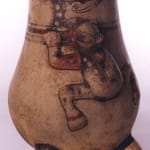Guanacaste-Nicoya Jaguar Effigy Vessel, 1200 CE - 1400 CE
Terracotta
9
PF.3566
During period VI, there was an increased production of white-slipped polychrome vessels in the northern part of the greater Nicoya sub area. The cream-slipped pottery was called Jicote polychrome. Although...
During period VI, there was an increased production of white-slipped polychrome vessels in the northern part of the greater Nicoya sub area. The cream-slipped pottery was called Jicote polychrome. Although Jicote painting on vessel has more matt quality than other styles, its designs are often bold and striking. This fascinating effigy vessel has the pear shape, which was popular in period VI, with round tripod supports. The band around the neck contains decorative patterns and zoomorphic figures, and thin black contour lines define the patterns and figures that are enhanced with orange-brown color. Moreover, it has an appliqué jaguar, which seem to be embracing the vessel. Intricately sculpted and boldly painted, the jaguar's face is expressive. Its large eyes are wide-open, and the open mouth displays the lethal fangs. Black painted patterns decorate the jaguar's face and its body is painted black in rectangular sections. Being a mythical creature and a revered animal for its power and agility, jaguar was a divine symbol often used by ancient Costa Ricans. Decorated with such a special creature, this effigy vessel must have embodied a particular significance. As we contemplate this beautiful vessel, we appreciate the great ancient culture and its expressive, artistic creation.



